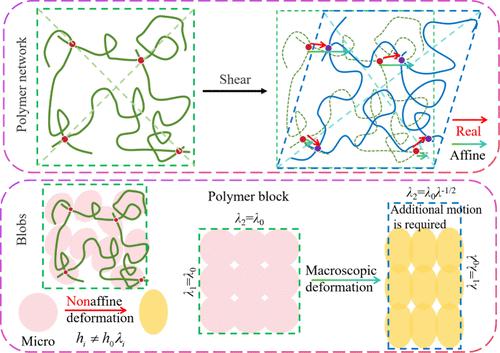A Nonaffine Model of Rubbery Polymers for Exploring Functionality Dependence and Blob Motion of Networks
IF 5.2
1区 化学
Q1 POLYMER SCIENCE
引用次数: 0
Abstract
This study proposes a novel nonaffine constitutive model to explore the functionality dependence and blob motion of rubbery polymer networks. The model posits that the deformation of polymer networks comprises two parts: the nonaffine motion of cross-linking points and the additional motion of polymer blobs. Building on the p-chain model, polymers are conceptualized as aggregates of homogeneous unit cells undergoing initial phantom deformations, followed by additional movements to align with macroscopic block deformations. The collapse of polymer blobs is analyzed through phantom network, kinetic energy, and the deformation gradient. The functionality (f) and the second invariant (I2) are identified as pivotal factors in understanding nonaffine deformations. The proposed model was validated using experimental data from vulcanized natural rubber, PAAm hydrogel, and P(BMA-co-MEA)-Li elastomers. The results demonstrate a strong alignment between theoretical predictions and experimental observations. This study provides new insights into the mechanical behavior of rubbery polymers and offers a robust framework for predicting their responses under diverse deformation conditions.

橡胶聚合物的非仿射模型用于研究网络的功能依赖和团运动
本研究提出了一种新的非仿射本构模型来探索橡胶聚合物网络的功能依赖和斑点运动。该模型认为聚合物网络的变形由交联点的非仿射运动和聚合物团的附加运动两部分组成。在p链模型的基础上,聚合物被概念化为均质单元细胞的聚集体,它们经历了最初的幻体变形,随后是与宏观块变形相一致的额外运动。从模态网络、动能和变形梯度等方面分析了聚合物团块的坍塌过程。功能化(f)和第二不变量(I2)被认为是理解非仿射变形的关键因素。利用硫化天然橡胶、PAAm水凝胶和P(BMA-co-MEA)-Li弹性体的实验数据验证了所提出的模型。结果表明理论预测和实验观察之间有很强的一致性。这项研究为橡胶聚合物的力学行为提供了新的见解,并为预测其在不同变形条件下的反应提供了一个强大的框架。
本文章由计算机程序翻译,如有差异,请以英文原文为准。
求助全文
约1分钟内获得全文
求助全文
来源期刊

Macromolecules
工程技术-高分子科学
CiteScore
9.30
自引率
16.40%
发文量
942
审稿时长
2 months
期刊介绍:
Macromolecules publishes original, fundamental, and impactful research on all aspects of polymer science. Topics of interest include synthesis (e.g., controlled polymerizations, polymerization catalysis, post polymerization modification, new monomer structures and polymer architectures, and polymerization mechanisms/kinetics analysis); phase behavior, thermodynamics, dynamic, and ordering/disordering phenomena (e.g., self-assembly, gelation, crystallization, solution/melt/solid-state characteristics); structure and properties (e.g., mechanical and rheological properties, surface/interfacial characteristics, electronic and transport properties); new state of the art characterization (e.g., spectroscopy, scattering, microscopy, rheology), simulation (e.g., Monte Carlo, molecular dynamics, multi-scale/coarse-grained modeling), and theoretical methods. Renewable/sustainable polymers, polymer networks, responsive polymers, electro-, magneto- and opto-active macromolecules, inorganic polymers, charge-transporting polymers (ion-containing, semiconducting, and conducting), nanostructured polymers, and polymer composites are also of interest. Typical papers published in Macromolecules showcase important and innovative concepts, experimental methods/observations, and theoretical/computational approaches that demonstrate a fundamental advance in the understanding of polymers.
 求助内容:
求助内容: 应助结果提醒方式:
应助结果提醒方式:


